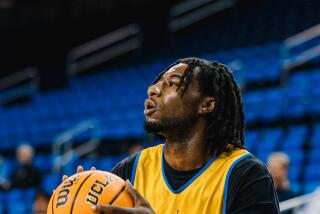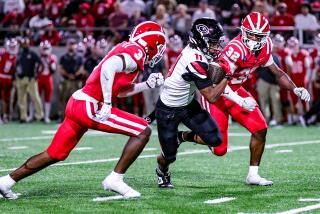An Athletic Prodigy in Every Way But One
FOXBORO, Mass. â He came to UCLA as one of his sportâs most heavily recruited athletes.
The University of Washington wanted him so bad, it let him run through the Husky Stadium tunnel with its football team.
He has already established himself as one of UCLAâs toughest athletes.
The shoulder is dislocated yet he refuses to sit, he played most of one game with what was later diagnosed as a concussion, and his back is killing him.
Then there is the lure of the big leagues.
In a few months, professional teams will try to entice him to forsake his final three years of eligibility to join a world of salaries, endorsements and possible worldwide fame.
Tall and strong, he is typical of todayâs athletic prodigy in every way but one.
His sport.
It is soccer.
Deal with it.
As todayâs nationally televised Major League Soccer championship game will show, the face of this countryâs cute little minivan of sports is changing.
No longer is it just for long-haired little guys with barrel legs. No longer is it off-season exercise for cross-country runners and clarinet players.
The face of soccer is the big, confident grin of UCLAâs Sasha Victorine, a simple kid from outside Sacramento who could have been an outfielder or a quarterback.
âBut I wanted a game where I could run, and attack, and use all of my skills,â he said.
It is a face matching those of Cobi Jones, Ante Razov, Jorge Salcedo and Greg Vanney, all former Bruins starting today for the Galaxy in its title match against D.C. United.
It is a face that does not cower at the mention of football, or turn red with the mention of shootouts.
It is a face that can be found in front of televisions at 2 a.m., watching physical English soccer, imitating it later on the field, ending the soccer stereotypes about Americans and courage.
Remember those jillions of little suburban soccer rats that everyone giggled about in the 1980s?
Well, they are growing up. And they are finally, slowly contributing to a change in the sportâs popularity among spectators.
Those who blindly repeat the soccer criticsâ mantra--nobody likes soccer after age 13 because nobody plays it after age 13--should witness the expected crowd of nearly 50,000 for todayâs championship.
Those who say American players canât help attract those kinds of numbers should look not just at the Galaxy, but at D.C. United, which features nine former collegians from the University of Virginia.
And those who wonder about an encore for this surprisingly successful league should stop by Spaulding Field next Friday and Sunday to watch the seventh-ranked Bruins (10-3) during their annual four-team MetLife Soccer Classic.
Victorine, former national high school player of the year and a true freshman, is only one of several athletes who could be doing something else.
One teammate has a black belt in karate. Another was a star point guard. Another was an all-star fielder in baseball.
One guy has played hockey. Another has been a track star. And defender Clay Kilbarger lettered in five sports.
Of two high school seniors reportedly being pursued by longtime Coach Sigi Schmid, one is a wide receiver and strong safety, and the other is a standout hurdler.
With exposure from the World Cup and MLS, athletes who cannot immediately make millions in other sports are now looking at soccer as a new chance at a nice paycheck and delayed adulthood.
Not to mention, an opportunity to hit somebody without pads. The more that typical American athletes are involved here, the more this happens.
âSoccer is not what people think it is,â Victorine said. âThe way itâs played now, it can get pretty rough.â
Victorine, tied for the team lead with four goals, said the roughest was in Indiana in September.
He dove for a ball and landed shoulder-first. The shoulder immediately dislocated. He was in such pain, it took trainers 10 minutes to get him off the field.
Doctors initially said he would sit out at least a month, and possibly require surgery.
A week later, with a splint and the resignation that he probably wouldnât have full use of his arm for several months, he was playing again.
He canât jump as high, or run as fast--ever try doing either without using your arms?--but he was playing.
âIâve seen some guys miss an entire season with that,â Schmid said. âBut this kid is an extraordinary leader. When he was told he would do it no further damage, he decided he could handle the pain.â
Pain? In a sport where hands are not allowed, how can an injured shoulder cause any pain?
Because while the sport is not ours, the accent still is. Which means the new breed of soccer is not without old-fashioned cheap shots.
âGuys know my left arm is hurting, so theyâll just grab it, pull it behind my back, knock me down on it, every game,â Victorine said. âThe pain shoots down your arm, you canât move the arm. But then after about three minutes, itâs OK again. You keep playing.â
Sasha Victorine laughed. He survives. So has soccer. Deal with it.
More to Read
Go beyond the scoreboard
Get the latest on L.A.'s teams in the daily Sports Report newsletter.
You may occasionally receive promotional content from the Los Angeles Times.







